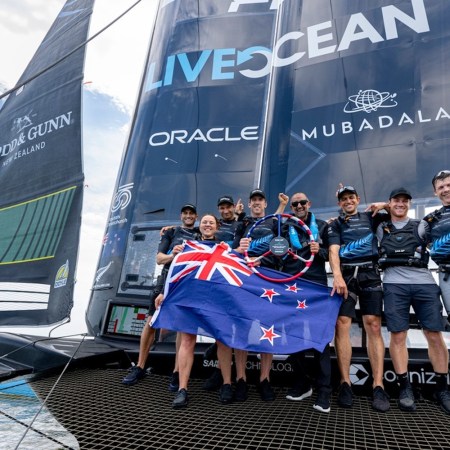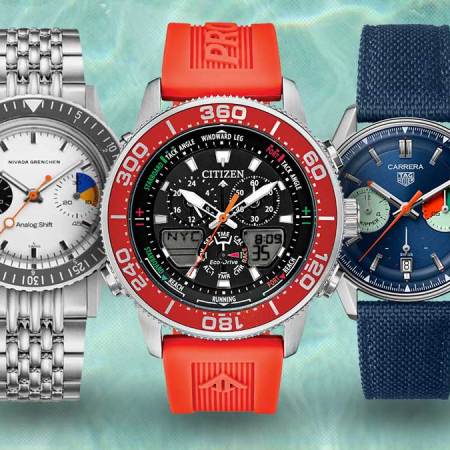One man. One 21-foot boat. 2,200 nautical miles. Meet Jerome Sammarcelli, our Man of the Month for June.
It’s the dead of night, 80 miles off Kauai, when the guides to the bowsprit snap. Everything is tangled.
The boom swings. The jib luffs.
Jerome Sammarcelli — alone, and tethered to his sailboat so he isn’t lost to the Pacific — scrambles over the deck in the dark, wearing nothing but boxers and a helmet.
There’s no crew. Nobody to help. Nobody to stare in bemused wonder at this 38-year-old man in soaked skivvies, fighting against a squall in the largest ocean in the world.
Just Sammarcelli, racing 2,100 miles from San Francisco to Hawaii in the Singlehanded TransPacific Yacht Race.
“You just want to give up,” he says. “Then you remind yourself you’re not the only one doing this, and you want to do it better than the others.”
“Better,” in this case, means sleeping for only 20 minutes at a time.
The race is fourteen days long, and Sammarcelli and his competitors are required to bring 30 days of food, most of it freeze-dried, in case they’re lost at sea.
But that’s only the half of it.
The other, even burlier half: Sammarcelli built this boat — the smallest boat in the race, a Mini Transat 6.50 that’s only 21 feet long.
And on that wet night in 2012, he was racing to prove that his company, Open Sailing, builds the toughest Mini-class ship in the world.
You’ve heard the phrase “actions speak louder than words?”
“There was no sales speech,” Sammarcelli says a year later. “The sales speech was going to Hawaii.”
It worked. And that gambit gave Sammercelli an even crazier idea. He decided to start his own Mini race – the first of its kind – from Marina del Rey to Hawaii.
It started Saturday. And it passes through some of the most treacherous and remote waters on Earth.
***
Sammarcelli grew up in France.
In summer he cruised the Mediterranean. In winter he raced the Gironde estuary, near Bordeaux. In a country where sailing is practically a national sport, he was very much at home.
“You drive next to a car, you want to go faster. It’s like that with sailing,” he says. “You don’t need an event. You just have to be on the water and you see another boat and you start chasing it and you want to go faster.”
That competitive bent might belie something more than a need for speed.
The world’s greatest singlehanded transatlantic race, the Transat 650, launches from France. Only Mini-class boats are allowed. The finish line is a dock in Brazil, some 4,000 miles away.
It’s a solo and masochistic race; not surprising, given the host country is L’hexagone.
And Sammarcelli might have stayed in France, if not for meeting his wife – an American girl studying abroad – while in college. Instead, he followed her all the way back to Marina del Rey, where he founded Open Sailing with his partner Nik Vale in ‘08.
“Marina del Rey is the largest man-made marina in the world and we are the only racing school,” he says. “Obviously the yacht clubs have racing programs for the kids. But nothing for the adults. Nothing on keel boats.”
With Vale, he teaches sailing and builds 5.70s and Pogo-2s, a popular European racer that’s often used in transatlantic competitions. He’s the only manufacturer of Mini-class boats in the U.S., and Sammarcelli and Vale have high hopes for the sport in Southern California.
Which is where the Mini 650 Pacific Challenge comes in. It’s limited to Mini-class boats – like the Pogos Sammarcelli and Vale build – and it’s the only Mini race from SoCal to Hawaii.
Sammarcelli is out there right now.
***
The Pacific Challenge’s route will take Sammarcelli through some of the most dangerous aquatic terrain on the planet.
While he won’t be sailing through Point Nemo — the Earth’s most notorious point of oceanic inaccessibility, named for Jules Verne’s indomitable captain — he will be near the infamous White Shark Café, a noted habitat for Great Whites.
Night sailing, he notes, could be a problem out there. No lights. Can’t see the marine life. Can’t even see the waves.
And then there are the search-and-rescue logistics.
“[The rescue] helicopter range is 259 miles,” Sammarcelli says, noting that at one point during his journey he’ll be over 260 miles from the nearest islands. “After that they can’t get to you. No one can get to you.”
But with characteristic aplomb, Sammarcelli brushes off the worries even as he mentions them.
His wife supports him, he says. And the risk is worth the reward. To his business. To his reputation. And to his family.
Recalling last year’s race, when he arrived in Hawaii and his son ran to hug him: “It was the first time I lived something like this as a dad,” he says.
“Just for that, I would do it again.”
Editor’s Note: as this story was being finalized for publication yesterday, InsideHook received word that Sammarcelli withdrew from the race due to a medical emergency at sea. He has since returned safely and will race again next year.
The Charge will help you move better, think clearer and stay in the game longer. Subscribe to our wellness newsletter today.























